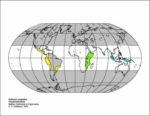Coffee and Location, Location, Location
Where Coffee Grows
The kind of coffee plant cultivars and varieties that make high-end coffee like that which NanoRoast sells exclusively grow in a fairly limited set of locations, a “coffee belt” that reaches roughly from the Tropic of Cancer 23.5 degrees North to the Tropic of Capricorn 23.5 degrees South, at elevations between 1200 and 2400 MASL (Meters above sea level) where there is rich volcanic soil, adequate water, shade from the hot sun, warm days/cool nights and not a lot of climate variation year round. In short, coffee is pretty picky about where it grows well, and some of the best locations are subject to volcanic eruptions, landslides and deforestation from human population pressure. Nevertheless, these risky locations can provide conditions for coffee to shine with the loving care the farmer gives.
Coffee aficionados stop short of classifying coffees by the cultivar or even the variety (except in the case of Gesha, perhaps) because the same varietal can taste very different when grown in different locations, or “origins” in coffee-speak. This is what wine lovers call “terroir,” and it applies to coffee, too.
Terroir – the Mystery of Specific Location
One of the mysteries of growing coffee in these locations is that even though one farm may tick all the boxes to grow a specific kind of coffee, its crop can exhibit differences from its neighbors that we can’t attribute to anything but location. The local microclimate, soil composition, nutrients, what is planted next to the coffee tree, geography and altitude influence terroir and have a major impact on the taste characteristics of the beans in the cup. For example, the Chikmagalur region of Southern India grows fairly mild arabica coffee, but it can sometimes pick up a peppery, spicy flavor from pepper and spice trees that shade the coffee plants. Another example is where Bourbon hybrids used in Kenya can be planted in El Salvador at the same elevation and yet they will differ in density and flavor profile. Island coffees gain their mild flavors from increased ocean-influence on local climates even though they may be grown on islands half a world away.
Bottom line: The biggest lesson from considering location as an influencer on coffee taste is that, to me, you cannot assume a Typica is a Typica is a Typica and know what that bean will taste like with certainty. However, the combination of cultivar/varietal and terroir still do not tell the whole story. What happens after the beans are grown and harvested provides the rest of the picture.

